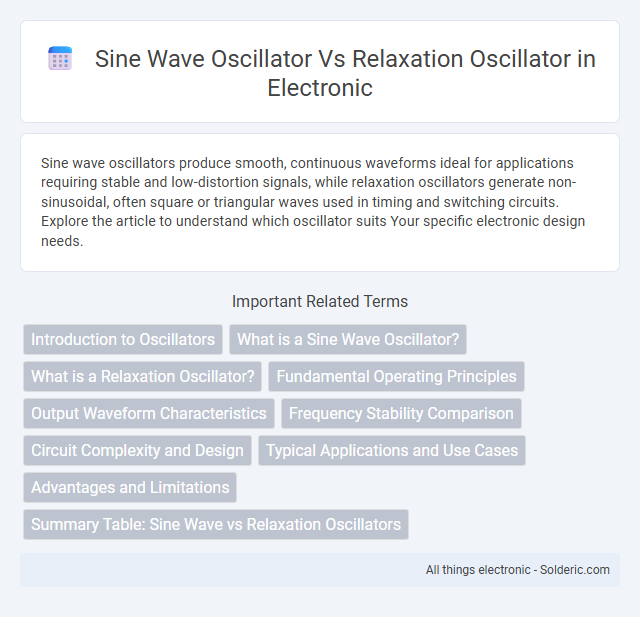Sine wave oscillators produce smooth, continuous waveforms ideal for applications requiring stable and low-distortion signals, while relaxation oscillators generate non-sinusoidal, often square or triangular waves used in timing and switching circuits. Explore the article to understand which oscillator suits Your specific electronic design needs.
Comparison Table
| Feature | Sine Wave Oscillator | Relaxation Oscillator |
|---|---|---|
| Waveform Output | Continuous, smooth sinusoidal wave | Non-sinusoidal, typically square or triangular wave |
| Frequency Stability | High stability and precision | Lower stability, frequency depends on charging/discharging time |
| Common Applications | Signal generators, communication systems, audio synthesis | Timing circuits, flashing lights, simple pulse generation |
| Complexity | More complex circuitry with tuned components | Simple design with fewer components |
| Power Consumption | Typically higher due to continuous operation | Typically lower, suitable for low-power applications |
| Examples | Wien Bridge Oscillator, LC Oscillator | Astable Multivibrator, Schmitt Trigger Oscillator |
Introduction to Oscillators
Oscillators generate periodic signals critical for various electronic applications, with sine wave oscillators producing smooth, continuous waveforms ideal for communication and signal processing. Relaxation oscillators create non-sinusoidal waveforms, such as square or sawtooth waves, commonly used in timing and switching circuits. Understanding the differences in waveform characteristics and applications helps you select the right oscillator type for your electronic design needs.
What is a Sine Wave Oscillator?
A sine wave oscillator generates a smooth, continuous waveform crucial for applications requiring pure frequency signals such as audio synthesis and communication systems. Unlike a relaxation oscillator, which produces non-sinusoidal waveforms like square or triangle waves through charging and discharging processes, a sine wave oscillator relies on harmonic resonant circuits to maintain a stable frequency output. Your choice depends on whether precise sinusoidal signals or simple timing pulses are needed for the specific electronic design.
What is a Relaxation Oscillator?
A relaxation oscillator generates non-sinusoidal waveforms, typically square or sawtooth waves, by repeatedly charging and discharging a capacitor through a resistor or using a switching device. Unlike sine wave oscillators that produce smooth, continuous oscillations ideal for AC signal generation, relaxation oscillators rely on abrupt voltage changes to switch states, making them suitable for timing, pulse generation, and flashing light circuits. You can use a relaxation oscillator in applications requiring simple, low-frequency waveforms rather than pure sine waves.
Fundamental Operating Principles
Sine wave oscillators generate continuous, smooth periodic signals using electronic components like inductors and capacitors in LC circuits or resistors and capacitors in RC circuits, maintaining constant amplitude and frequency. Relaxation oscillators produce non-sinusoidal waveforms such as square or triangle waves by charging and discharging a capacitor through a resistor until a threshold voltage triggers a rapid state change. Your choice depends on whether a stable sinusoidal output or a simpler, non-sinusoidal waveform suits your application's fundamental operating principle.
Output Waveform Characteristics
Sine wave oscillators produce smooth, continuous, and periodic waveforms with a single fundamental frequency and minimal harmonic distortion, ideal for applications requiring stable and pure signals. Relaxation oscillators generate non-sinusoidal waveforms such as square, triangular, or sawtooth waves characterized by rapid transitions and high harmonic content, making them suitable for timing and waveform generation circuits. The output waveform characteristics directly influence the choice of oscillator based on the required signal purity, frequency stability, and harmonic profile.
Frequency Stability Comparison
Sine wave oscillators exhibit higher frequency stability due to their operation based on resonant circuits like LC tanks or crystal oscillators, which maintain consistent oscillation frequencies. Relaxation oscillators rely on charging and discharging of capacitors through resistors, causing more frequency variation influenced by component tolerances and temperature changes. Your choice depends on the need for precise frequency control, where sine wave oscillators are preferred for stable and low-distortion signals.
Circuit Complexity and Design
Sine wave oscillators feature more complex circuit designs involving resonant components like inductors and capacitors to produce smooth, continuous waveforms with minimal distortion. Relaxation oscillators utilize simpler circuits based on switching elements such as transistors or operational amplifiers that generate non-sinusoidal waveforms through charge and discharge cycles. Your choice depends on whether you prioritize a pure frequency output with intricate design or a straightforward circuit with broader waveform applications.
Typical Applications and Use Cases
Sine wave oscillators are typically used in applications requiring low distortion and precise frequency, such as audio signal generation, communication systems, and function generators. Relaxation oscillators are common in timing circuits, flashing lights, and pulse generation due to their simple design and ability to produce non-sinusoidal waveforms. Each oscillator type suits distinct use cases based on waveform purity and application-specific frequency stability requirements.
Advantages and Limitations
Sine wave oscillators generate smooth, continuous waveforms ideal for high-frequency applications requiring low distortion, making them advantageous for audio and RF signal generation. Relaxation oscillators produce non-sinusoidal waveforms like square or triangular waves, offering simple design and easy frequency control but higher harmonic distortion and less spectral purity. Your choice depends on whether waveform purity or circuit simplicity is more critical for the application.
Summary Table: Sine Wave vs Relaxation Oscillators
Sine wave oscillators generate smooth, continuous waveforms with stable frequency and low harmonic distortion, ideal for audio and RF applications. Relaxation oscillators produce non-sinusoidal, often triangular or square waveforms, characterized by simpler circuits and lower frequency stability, commonly used in timing and flashing light circuits. Your choice depends on the need for waveform purity versus circuit simplicity and frequency range.
Sine wave oscillator vs Relaxation oscillator Infographic

 solderic.com
solderic.com